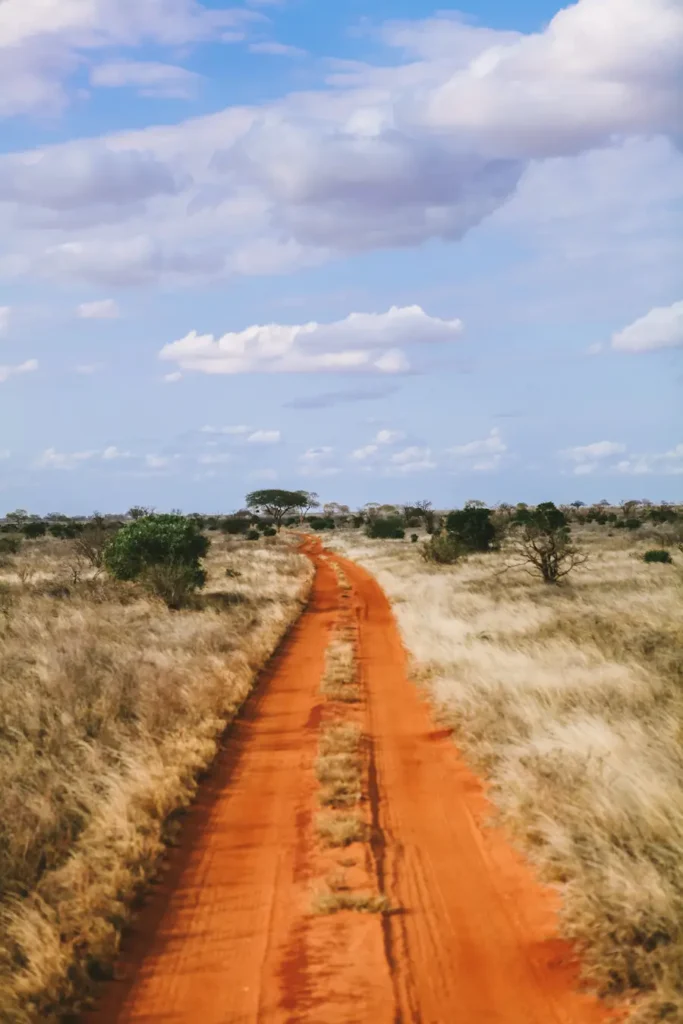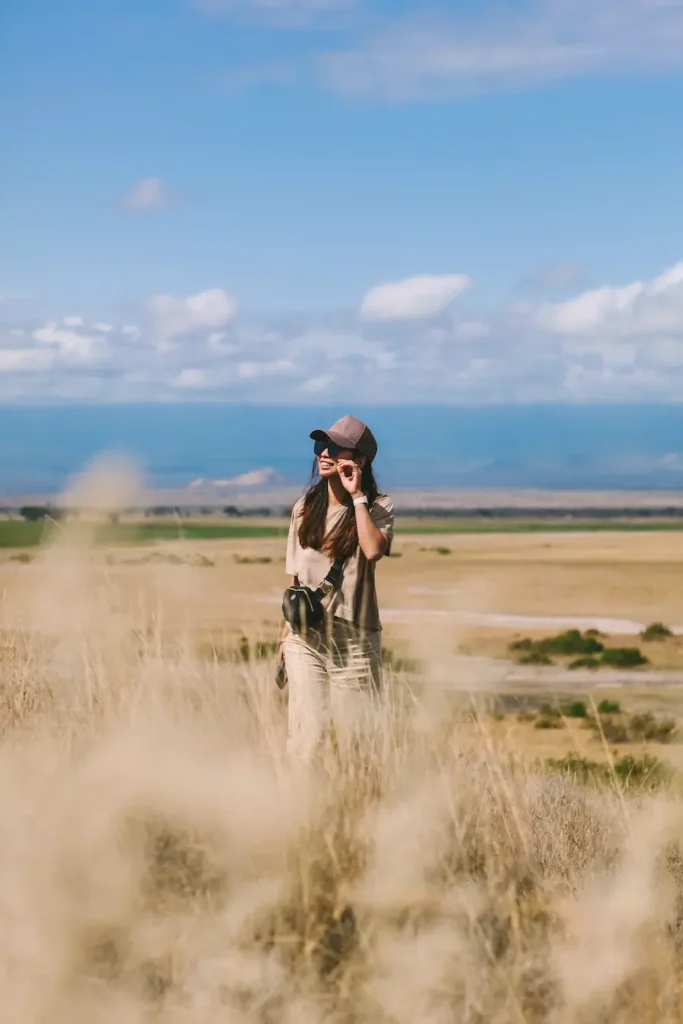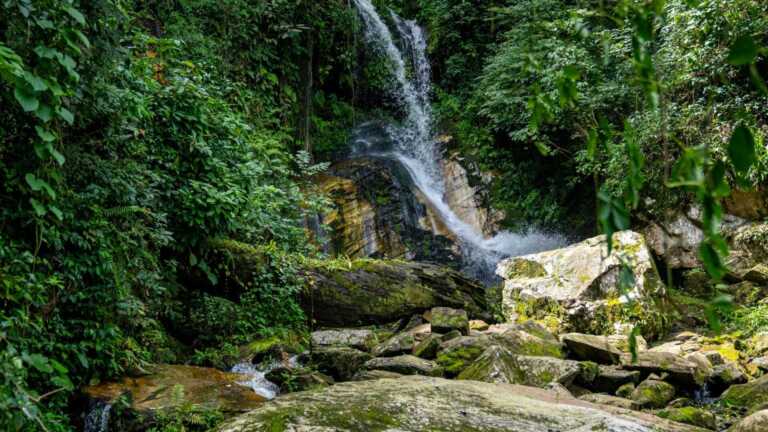Kenya Travel Guide: itinerary, tips, budget, all you need to know
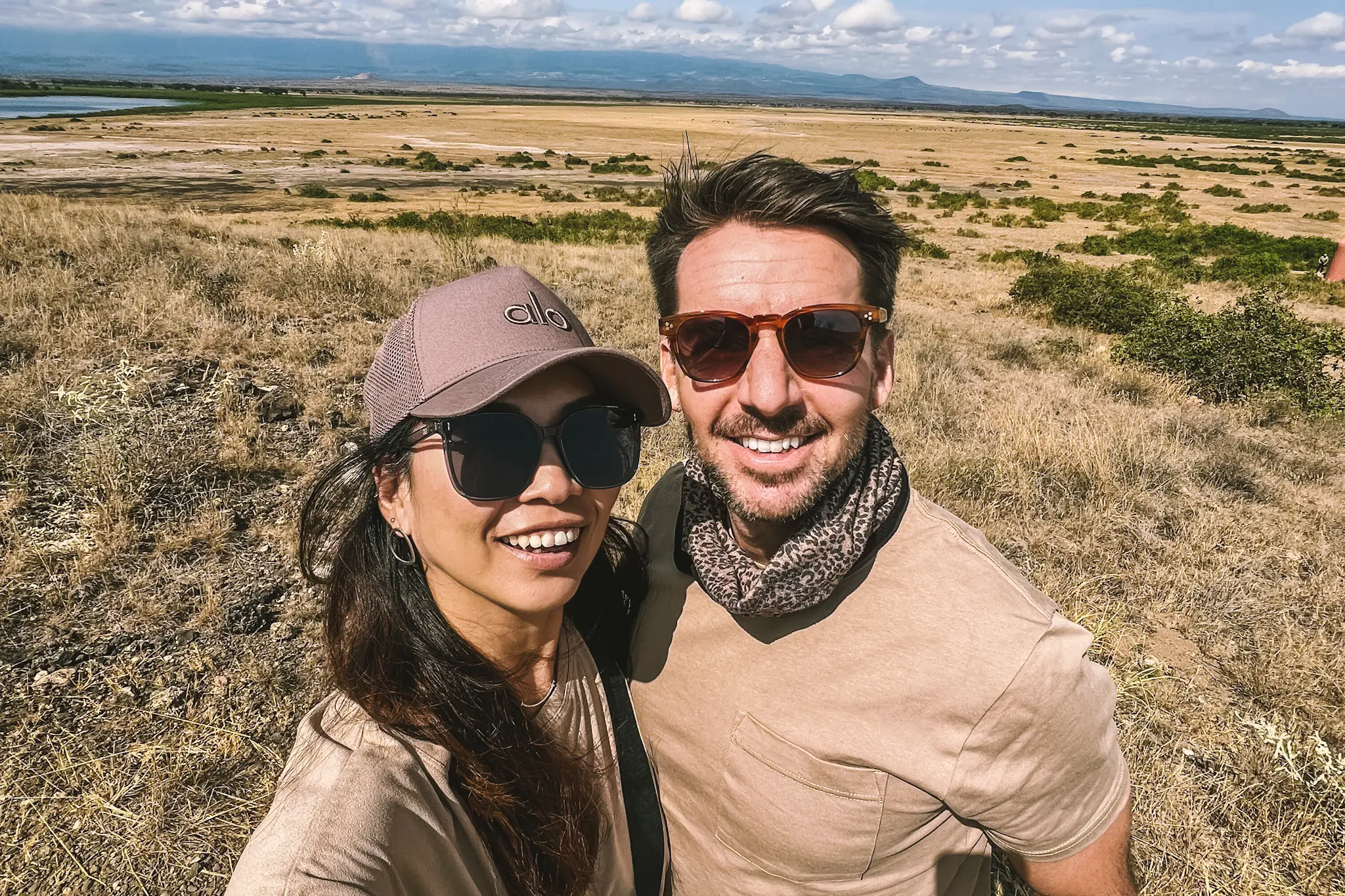
BEST ITINERARY IN KENYA? HOW TO BOOK MY SAFARI? IS KENYA SAFE?
Here we go! We’ve just returned from one of the most unforgettable trips of our lives: KENYA! And we can’t wait to share it all with you.
We spent nearly two weeks (12 days to be exact) exploring this incredible country through a series of unforgettable safaris, by 4×4, boat, and even on foot (with the option of a hot air balloon for the adventurous!). To top it all off, we ended our journey relaxing on the stunning beaches of the Indian Ocean.
For this trip, both of us set off on a tailor-made private tour created by Native Afrika, a local agency, which honestly, we can’t recommend enough (later in this blog, we will talk more about why we went through an agency, which is actually pretty much a must when traveling to Kenya).
This 12-day trip took us to the heart of the savannah, on captivating safaris where we were amazed by lions, elephants, buffalo, cheetahs, rhinos, monkeys, zebras, giraffes, gazelles, birds, and a lot more! Needless to say, if you love nature, this is “the place to be”!
HIGHLIGHTS ABOUT A TRIP TO KENYA:
– The Masai Mara: the most well-known park in Kenya. You must visit it! And if you are lucky you can spot the wildebeest great migration!
– Amboseli National Park to observe elephants with Mount Kilimanjaro as a backdrop: our personal favorite.
– Tsavo National Parks (East & West): the largest park in Kenya, with plenty of wildlife to observe.
– You like Rhinos? Then make a stop at Lake Nakuru.
– Finish your trip at the coast, at Diani Beach, for some relaxation and to observe dolphins!
You must be pretty excited by now! But at the same time, you probably have hundreds of questions to start planning your trip to Kenya! No worries, you are not alone, we were feeling the same, super overwhelmed with tons of information online and not knowing where to start.
Hence, we compiled all our travel tips and added a FAQs with the most common questions for a trip to Kenya.
GUIDE TO KENYA
1. Our recommended itinerary to visit Kenya

Here is our exact itinerary for our 12-day trip to Kenya:
- Day 1: Nairobi
- Day 2 & 3: Masai Mara
- Day 4: Lake Naivasha
- Day 5: Lake Nakuru
- Day 6-7: Amboseli National Park
- Day 8: Tsavo West
- Day 9: Tsavo East
- Day 10 & 11: Diani Beach
- Day 12: Nairobi (flying home the same day)
We did everything in a Jeep, except on the last day, we took a small local flight from Diani Beach to Nairobi and flew home on the same day.
We didn’t drive the Jeep ourselves, but hired a guide (arranged by Native Afrika).
Our Opinion:
We enjoyed our itinerary as we could observe a variety of landscapes and wildlifes. Which was truly amazing.
Now be aware that going on a safari trip involves spending pretty much the entire time in a car and waking up early (it’s best to start at 7 am to see more active wildlife). Besides going from 1 National Park to another often takes half a day!
If we were to do it again, we would probably skip Lake Naivasha (famous for taking a small boat trip to see hippos, since we actually saw plenty of them in Amboseli). We would then add more days in Masai Mara and Amboseli, since both parks were the absolute highlights of our Safari trip to Kenya.
Overall, 10 to 15 days seems to be the ideal time to spend in Kenya. Though if you are a complete fanatic of wildlife or photography, you could easily stay longer.
But for us, Kenya being our first “real” safari trip (besides our 1-day Safari in Sri Lanka), we felt that 12 days was perfect, including 2.5 days resting by the beach in Diani.
(Later in this article, we will describe the highlights of each location we visited in Kenya.)
2. How to book your Safari to Kenya?
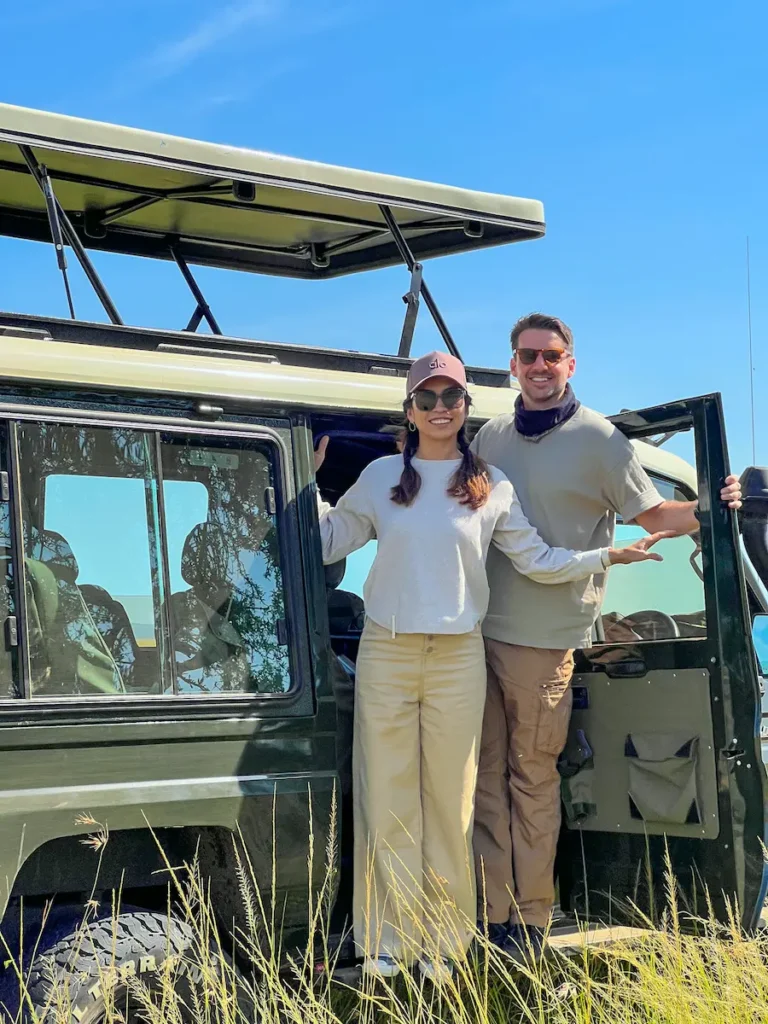
To be honest, in all our travels, we’ve never asked a travel agency to book our trip, and we would always prefer a self-drive adventure.
However, after reading information online, watching YouTube videos (especially from Ella McKendrick), we quickly understood that going through an agency is the way to go for a trip to Kenya.
For a stress-free and tailor-made experience, working with an agency is key to preparing for your trip to Kenya, as there are so many things to think of:
- Itinerary
- Jeep + Guide (having a guide during safari is a must if you want to optimize your chance to spot wildlife)
- Hotel booking in each destination (including food) -> Not all hotels can be booked online via a traditional website
- Internal flights, if you decide to take one
- National Parks entrance fees (it’s not cheap!)
- Insurance
- Etc.
So we contacted Ella McKendrick on Social Media, and she recommended a few agencies: Native Afrika, Meektrails Safaris, and Beyond The Plains Safaris.
We decided to ask a quote from all 3 operators in order to compare prices and services etc. Natike Afrika was actually the first to respond with a tailor-made quote within 24 hours. And eventually turned out to be the one who provided the best value for money (this is not sponsored, it’s just our honest opinion).
From there onwards, things got really smooth, as Native Afrika (Melvin was the person in charge of our trip), answered all our questions. We then further refined our itinerary based on their recommendations and what we wanted to focus on.
Our Opinion:
Once you get your first quote, feel free to check the hotels review online. We had some concerns based on the online ratings for 1 or 2 hotels proposed by Melvin. So we asked him to change.
Melvin also gave us multiple options in terms of vehicle (Jeep vs. Mini Van. Please take the Jeep, you won’t regret it, although it’s a bit more expensive), in terms of hotels (5 stars, 4 stars, 3 stars etc.) and in terms of activities (e.g. Hot Air Balloon, Dolphin tour in Diani etc.).
Overall, Melvin took care of pretty much everything for us and was very responsive.
Once you complete your itinerary with your agency, you will be asked to pay 20% to secure the booking. And you will pay the rest on Day 1 of your Safari (credit card payment is accepted).
3. How much did it cost to travel to Kenya?
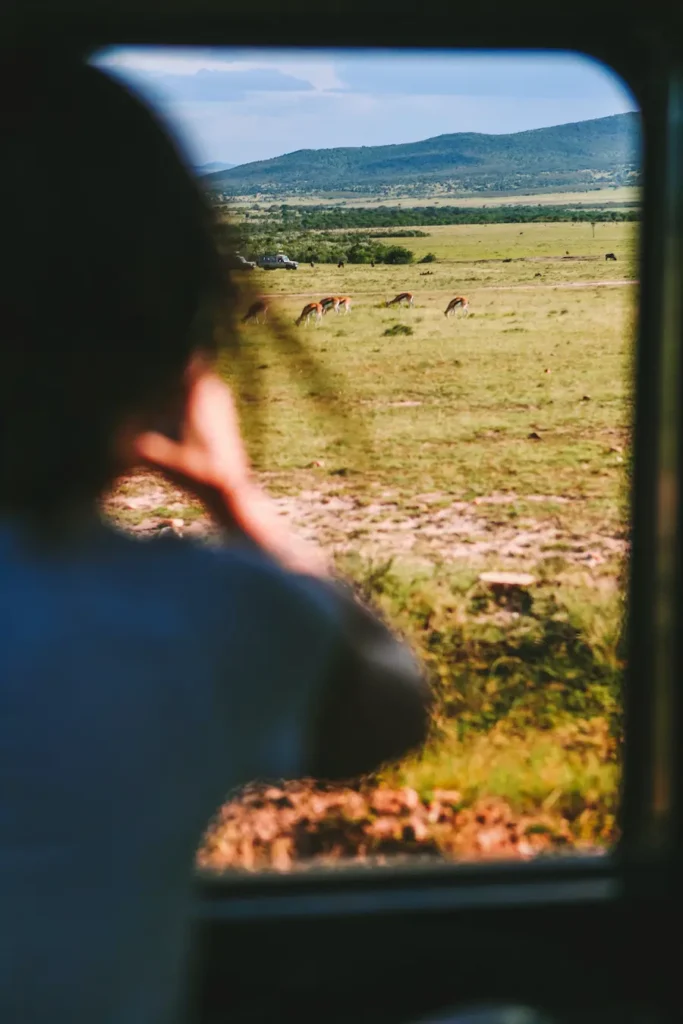
Let’s not beat around the bush! Kenya is not cheap.
The total cost for the 2 of us, for 12 days, including literally everything except the flights from our home country (activities, 4 to 5-star hotels, full board food, guide, jeep, national park entrance, etc.) was USD 7,164.
Does it seem expensive? At first, this was our reaction. But eventually, we spent very little money during our trip (mostly for tips, buying snacks, or souvenirs). We probably spent less than USD 500 in 12 days.
The entrance to National Parks is not cheap either, for example, at Amboseli it’s USD 70 per person per day in high season!
This also excluded the Hot Air Balloon tour, which is about USD 450 per person! We decided to skip it, though most feedback we got from other fellow travelers is that it was STUNNING.
Bear in mind, the overall cost can be cheaper if you choose 3 stars hotel or less, or it can be around USD 10K if you only pick 5 stars hotels.
Also, tipping is very common and expected (by hotel staff, waiters etc. and most importantly, your travel guide! Tipping guideline is USD 10.00 pp per day of Safari.
4. When is the best time to visit Kenya?
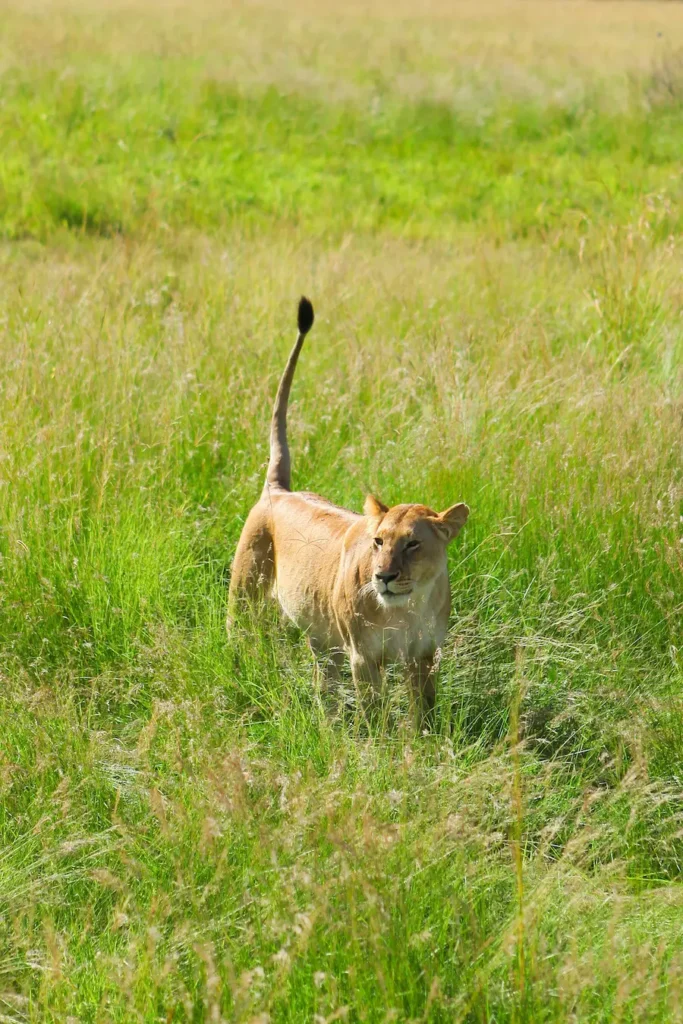
This is becoming a harder question to answer. Indeed, due to climate change, things are getting more and more difficult to predict. But generally:
The dry season runs from December to March and from the end of June to October (July-October is the period of the great migration in the Masai Mara). This is the best time for safaris, as the vegetation is less dense, making it easier to spot animals. In fact, many animals congregate near watering holes, making them easier to spot. Furthermore, temperatures are pleasant during the day but can be chilly in the mornings and evenings.
The rainy seasons occur in April, May, and November. These can make some parks less accessible due to muddy roads; however, the landscapes are greener, and accommodation rates are lower.
If your main activity is safari, the dry season is recommended; however, if you want to avoid the tourist crowds and enjoy lower prices, the rainy season can be a great idea. Some animals are becoming rarer, but they remain visible all year round.
As for us, we traveled to Kenya end of June till the first week of July! The weather was perfect, with very little rain, and really pleasant temperatures throughout the entire trip.
However, we missed the great migration in the Masai Mara, which is becoming more and more difficut to predict. Oh well, it gives us a good reason to come back 😉
5. Other important tips for your trip to Kenya
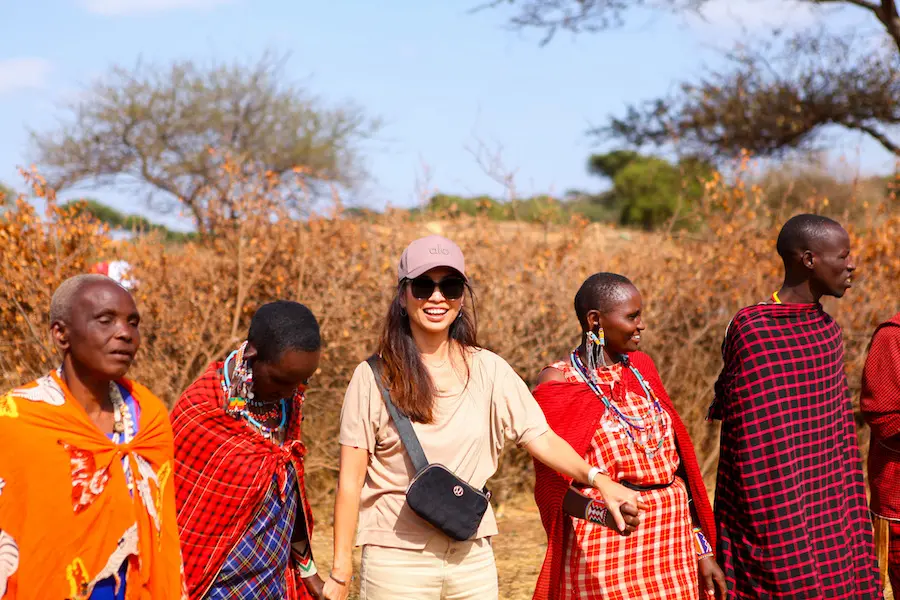
Visa:
Apply for your visa online (for eligible nationalities) at https://etakenya.go.ke. The cost of this ETA is USD 30.
We applied 2-3 weeks in advance (you will need to upload your flight ticket and hotel voucher, which your travel agency will provide). We got our ETA within 24 hours. Print your visa, as you need to show the QR code at immigration.
Required Vaccinations in Kenya:
Please note that for travelers coming from countries with a risk of yellow fever transmission, a yellow fever vaccination certificate is required! As we lived in Malaysia during that time (in 2025) we had to get our yellow fever vaccines. The certificate was required when boarding our flights.
It’s highly recommended to be up to date on routine vaccinations such as diphtheria, tetanus, pertussis, and hepatitis B before traveling to Kenya. Ideally, consult your doctor at least two months prior to departure to discuss which vaccines are necessary for you.
Our doctor also advised us to take preventive medication for malaria, as there is currently no vaccine available. We decided to take the pills, although fortunately we never got bitten by mosquitoes.
That said, if your trip includes areas around Lake Victoria, taking malaria prevention medication is strongly advised; it’s considered essential in that region…
Currency in Kenya
In Kenya, the official currency is the Kenyan shilling (KES); however, the US dollar is widely accepted at lodges and tourist sites.
However, for tipping, make sure you have small change.
Languages spoken in Kenya
The official languages of Kenya are English and Swahili.
As the official language, English is widely used in government, education, and commerce.
Swahili is a national Bantu language in Kenya. It is widely spoken in everyday life.
In addition, Kenya is home to a diversity of ethnic languages spoken by different communities. These languages include, among others, Kikuyu, the largest ethnic group in Kenya; Luo, a major ethnic group around Lake Victoria; Luhya in western Kenya; and the Kalenjin languages.
Learn some basic vocabulary in Swahili, locals will be so happy!
- Hello: Jambo (you will hear Jambo or “Jambo-Jambo” all the time. This was will be easy to remember)
- How are you: Habari Gani?
- No worries / No problems: Hakuna Matata (also easy to remember if you watched the Lion King)
- Yes / No: Ndiyo / Hapana
- Thank you very much: Asante sana
- No thank you: Hapana asante
- You’re welcome: Karibu
- Please / Excuse me: Samahani
- Goodbye: Kwaheri
- How much is it: Bei gani?
6. Best things to see in Kenya?
Nairobi:
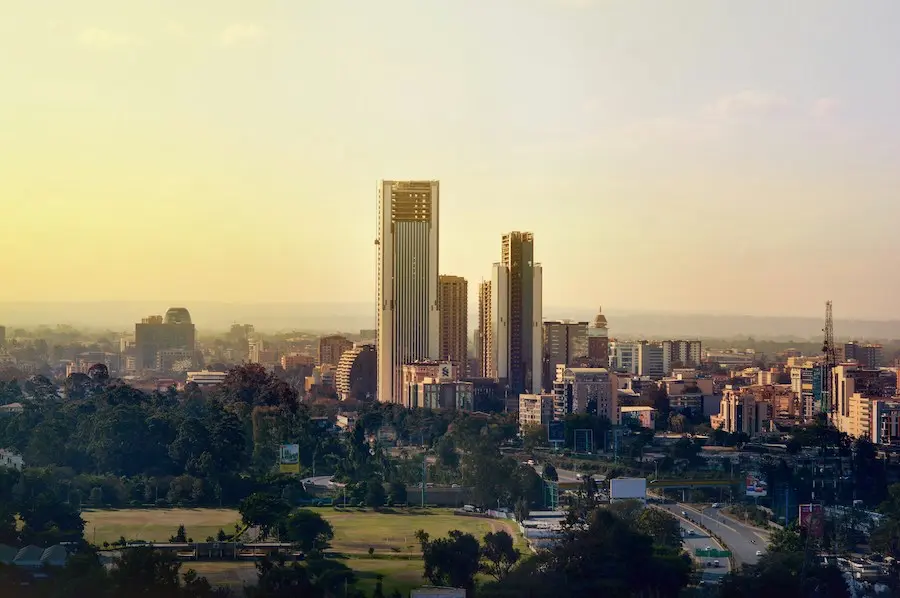
After an 8-hour direct flight from Kuala Lumpur in Malaysia with AirAsia, we landed at Nairobi’s main airport: Jomo Kenyatta Airport (NBO). It was already very late when we landed, so we went straight to our hotel, enjoyed dinner and a good night’s sleep, as our safari journey started the very next day at 6:30 am.
So we decided to completely skip the visit to the city. To be honest, as we have always lived in big cities, so we were just so impatient to go to the wild!
But, if time allows and if you feel like having a visit to Nairobi (which appeared very modern with multiple skyscrapers, to our surprise), your agency can organize a day tour with you.
Our Accommodation for 1 night: Boma Nairobi (5 Stars). It was perfect for us, about 20min to the airport, and a great place to start our Safari the very next day:
The Maisa Maara:
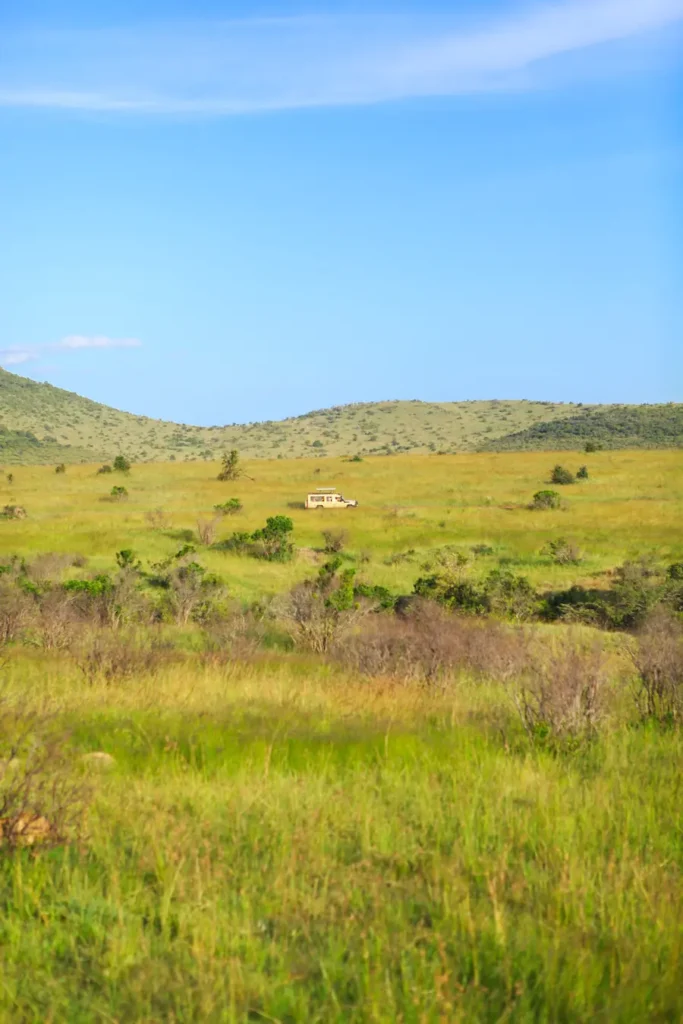
After one night in Nairobi, we met our driver and guide (Steven – his social media) and his jeep, waiting to set off to explore the Kenyan savannah.
We left the hotel early and spent the morning driving to the Masai Mara National Reserve in southwest Kenya. The drive was long, but the views of the Great African Rift Valley punctuated our journey, making it spectacular.
After nearly six hours of driving, we discovered our hotel at Masai Mara Sopa Lodge, ate lunch and then set off for a half-day evening safari before continuing from morning to evening the next day.
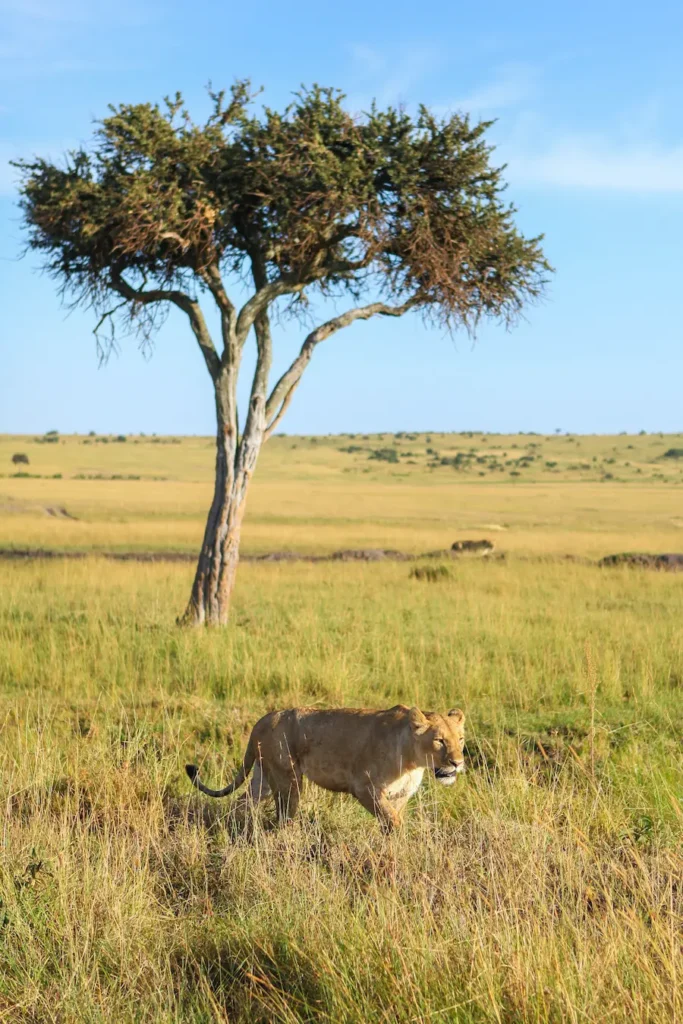
The Masai Mara Reserve borders the Serengeti National Park, and together, they form the most diverse ecosystem in Africa. Home to more than 95 mammal species and over 400 bird species, the Masai Mara is a wilderness where majestic herds of wildebeest, zebras, and antelope roam the grassy savannah. It’s also the realm of predators, where you will have the chance to spot your first lions.
But the Masai Mara is not just a wildlife sanctuary. It is also the ancestral homeland of the Maasai, a resilient tribe whose traditions and culture are closely tied to this sacred land. Their traditional villages dot the landscape, testifying to a centuries-old harmony between man and nature.
It is also at the Masai Mara that you can see the Great Migration of Wildebeest.
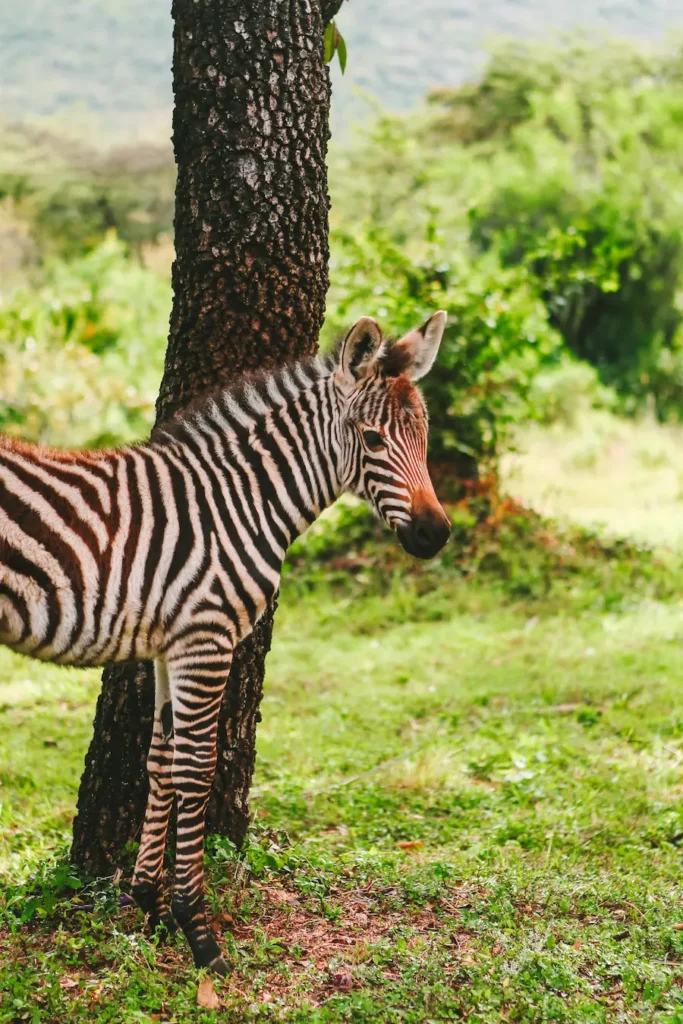
Our Accommodation for 2 nights: Masai Mara Sopa Lodge. And we absolutely loved it. We had zebras grazing right at our doorstep, and it was incredible to realize we were sleeping in the heart of so much wildlife.
Lake Nakuru:
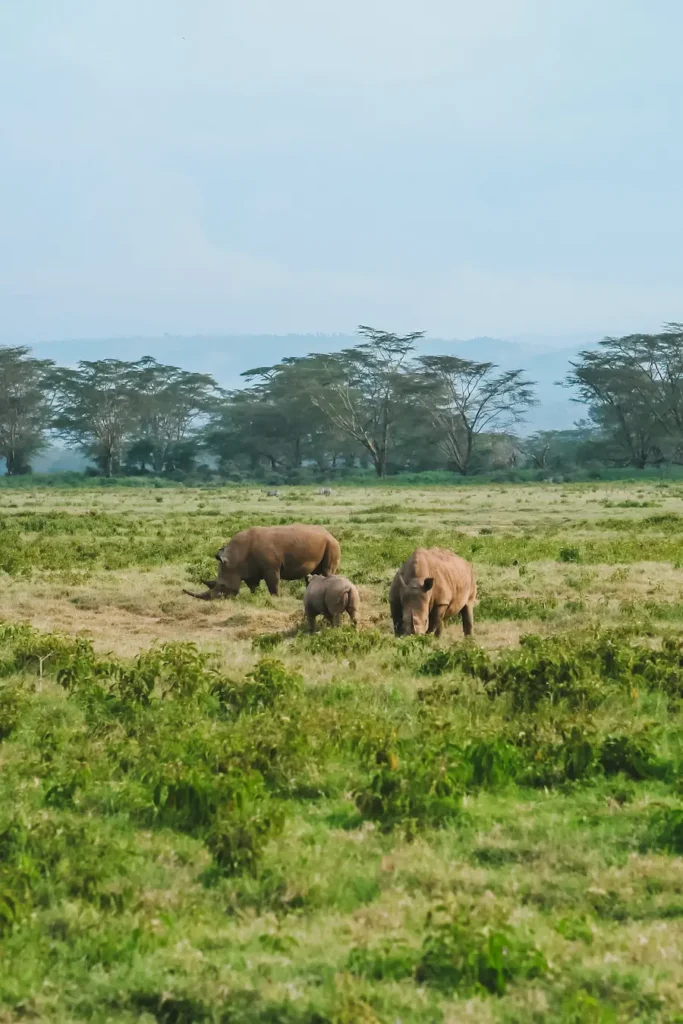
We’ve always wanted to see Rhinos. And fortunately, Lake Nakuru is one of the best places to see both black and white rhinos, endangered Rothschild’s giraffes, and lions that climb trees.
However, note that the vast majority of pink flamingos left Lake Nakuru due to lower water quality. Indeed, Lake Naruru is only a few minutes away from the busy and growing town of Nakuru… So if you look at photos online of Lake Nakuru with thousands of flamingos, note that this is not the case anymore. Sadly…
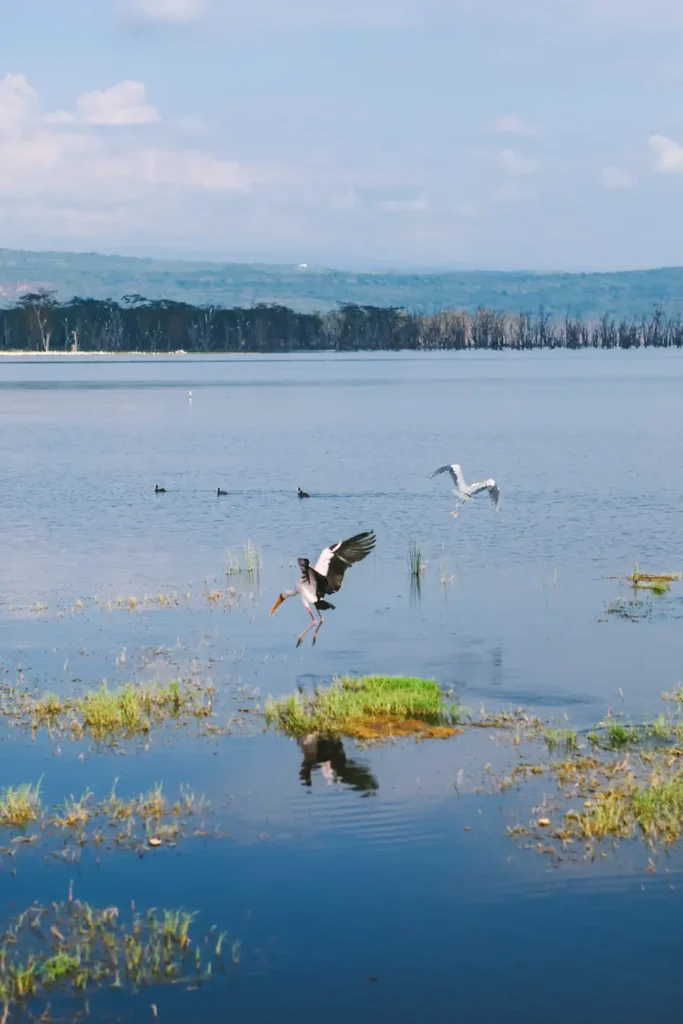
Despite this, Lake Nakuru remains really beautiful and allowed us to spot multiple white and black rhinos, as well as other animals such as numerous hyenas, lots of different birds, buffalo, zebras, and giraffes.
The drive from the Masai Mara took us 5 hours.
Our Accommodation for 1 night: Flamingo Hill Camp. This was our first “tented camp” experience in Kenya and we loved it! In fact, Flamingo Hill Camp was one of our favorite hotels during our entire trip. And the staff was so friendly! We would always remember it.
Lake Naivasha
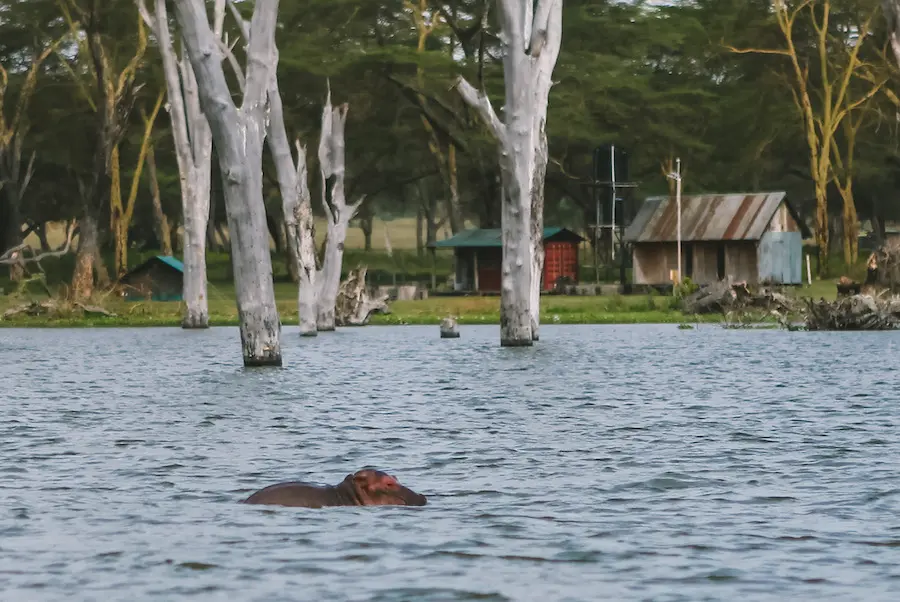
After an amazing start to our safari, we headed to Lake Naivasha. And only 2 hours away from Lake Nakuru!
After our lunch at Sawela Lodges, we set off on a boat safari on Lake Naivasha. On a motorboat, we set out to encounter hippos, eagles, herons, pelicans, and many other birds.
The boat stopped on Crescent Island, a wildlife sanctuary in the middle of the waters. There we could see lots of wildlife up close. It was perfect to take unforgettable shots.

Our honest opinion about Lake Naivasha: if you go there to see hippos (which is the main draw), we would then recommend skipping it. You can see hippos in the Masai Mara and at Amboseli Park (which we enjoyed the most).
We were excited by the boat trip at Lake Naivasha, but it’s extremely touristy to our taste, which made the whole experience less pleasant.
Our Accommodation for 1 night: Sawela Lodge. The best part about Lake Naivasha was actually the hotel, a gorgeous and vast park by the lake. Besides, they served some of the best foods we had during our 12-day trip to Kenya!
Amboseli National Park
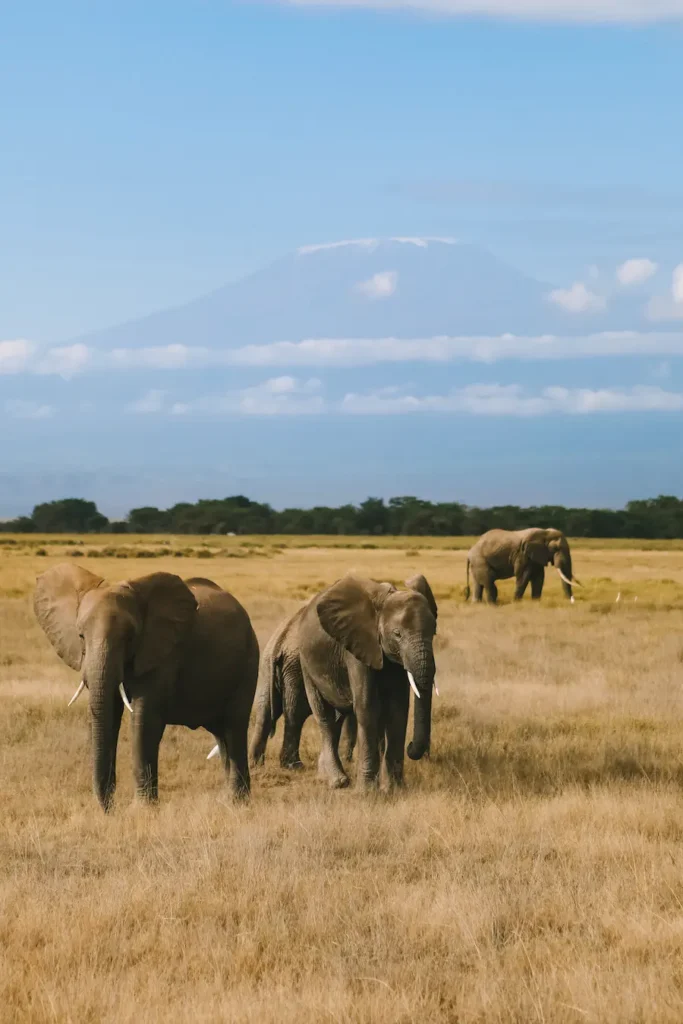
More than six hours’ drive from Lake Naivasha, we went south, close to the border with Tanzania, right by the legendary Kilimanjaro (the highest mountain in Africa). And yes, seeing this high peak covered in snow, while driving through Amboseli, was a magical experience.
If we were to pick only 1 place to visit in Kenya, it would be without hesitation Amboseli National Park!
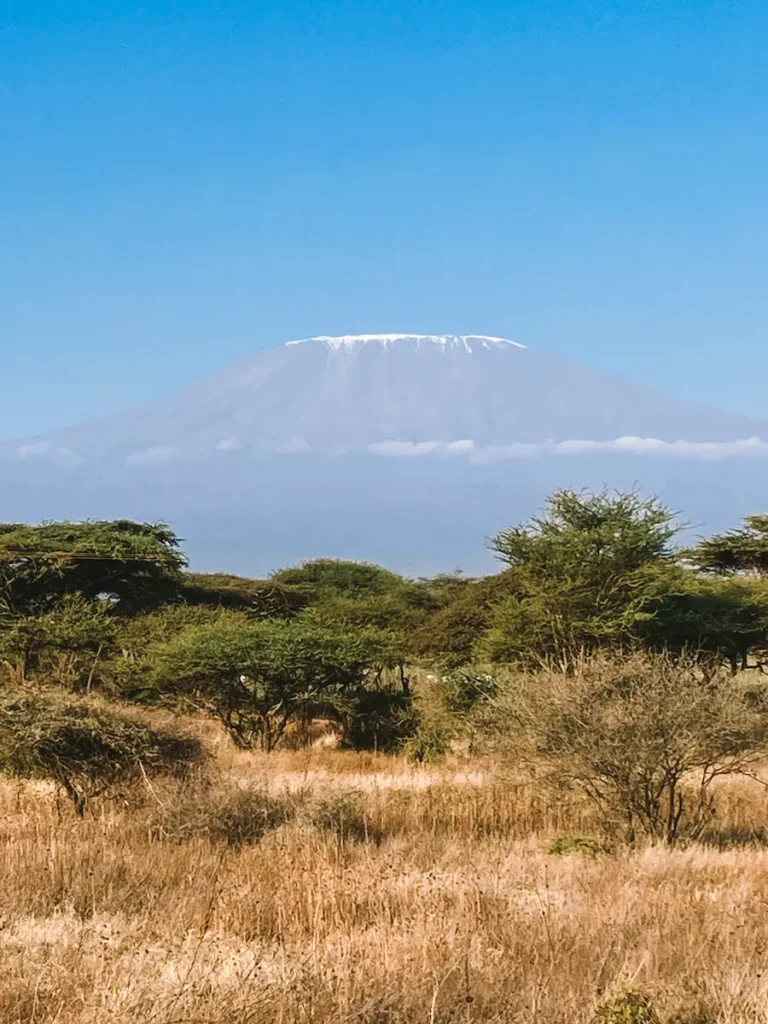
This park is especially renowned for its vast herds of elephants, and we witnessed some spectacular scenes! We also encountered cheetahs, buffalo, wildebeest, giraffes, and several hyenas, all looking for something to eat.
Amboseli is also home to the Maasai tribe. Hence, we also decided to visit a local village, where the Maasai shared with us their way of life, showed us how they make fire, hunt, and showed us their homes. It was a rich experience for us.
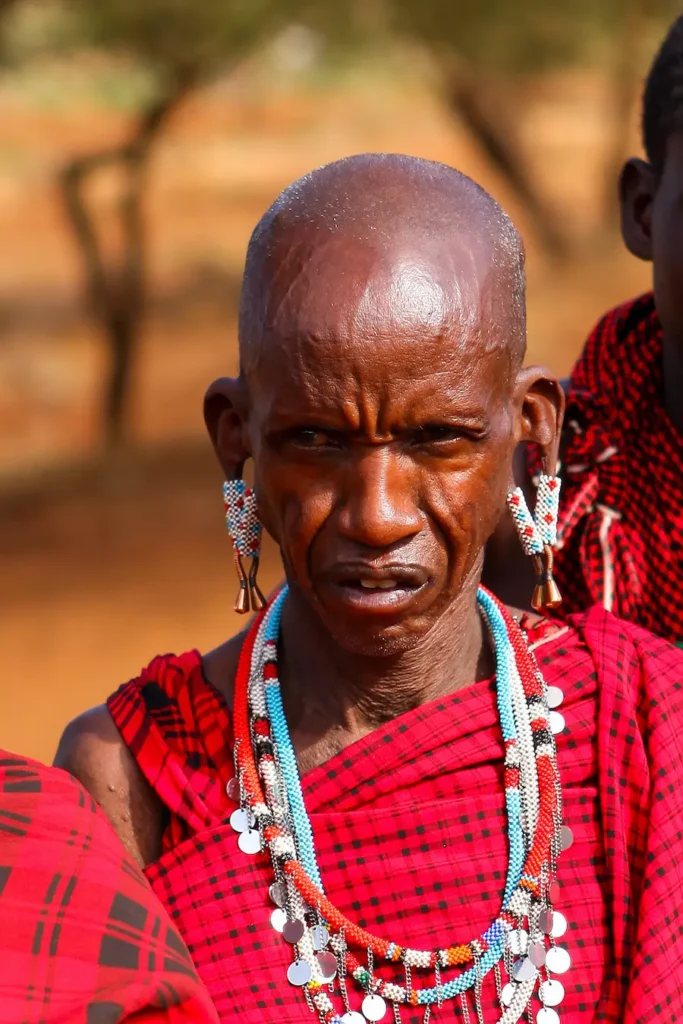
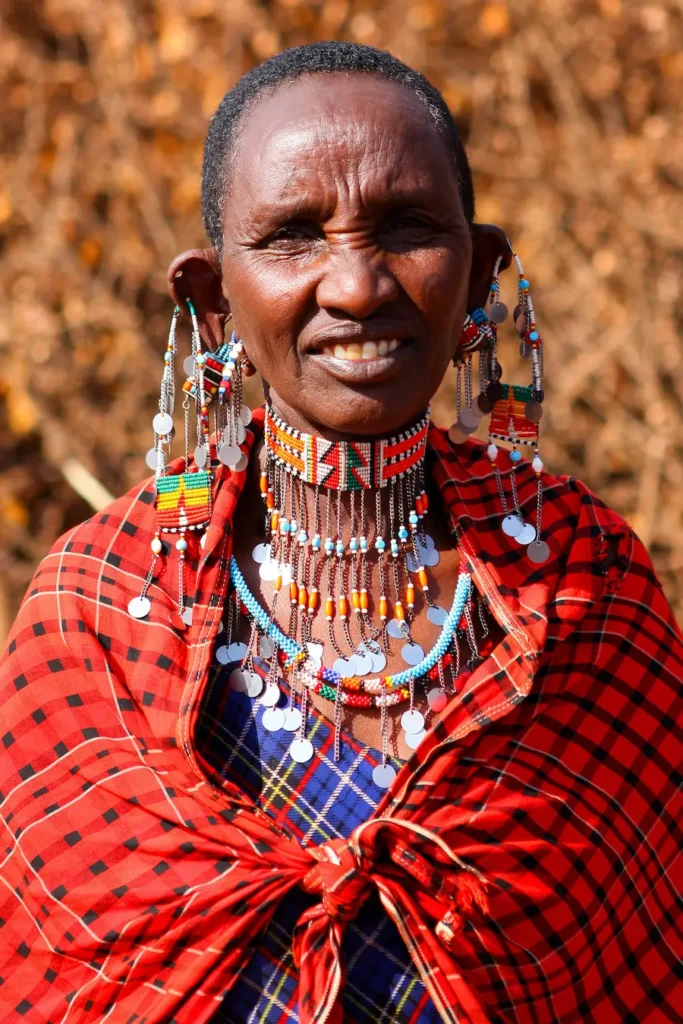
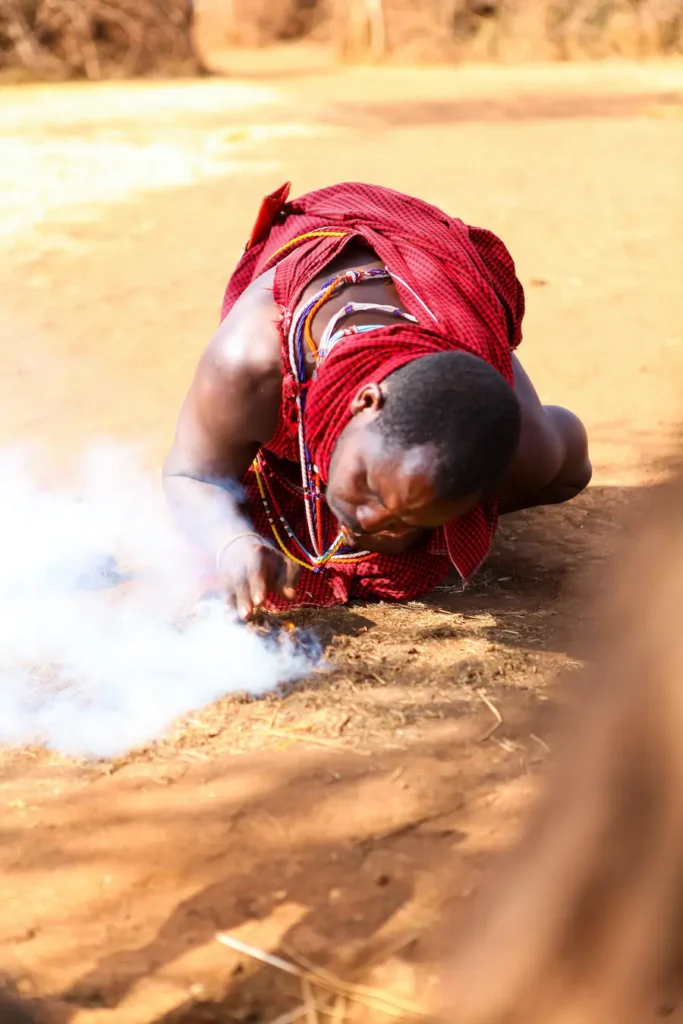
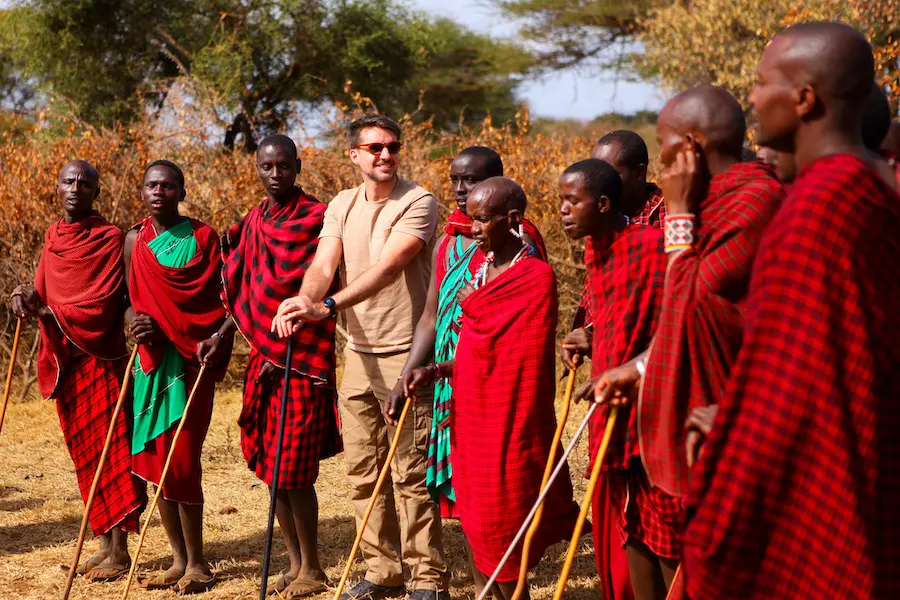
During our stay at Amboseli, our guide decided to surprise us with a sundowner. He stopped somewhere in the wild and brought of bottle of red wine, which we enjoyed in his company. It was an unforgettable moment (and quickly became our tradition during the rest of our trip!).
We stayed 2 nights at Amboseli Sopa Lodge in a fabulous location, directly facing the Kilimanjaro (however, it required a 30-minute drive each day to reach the entrance of Amboseli National Park)… Having said that, we would go there again, and add at least 1 more night!
Tsavo West National Park
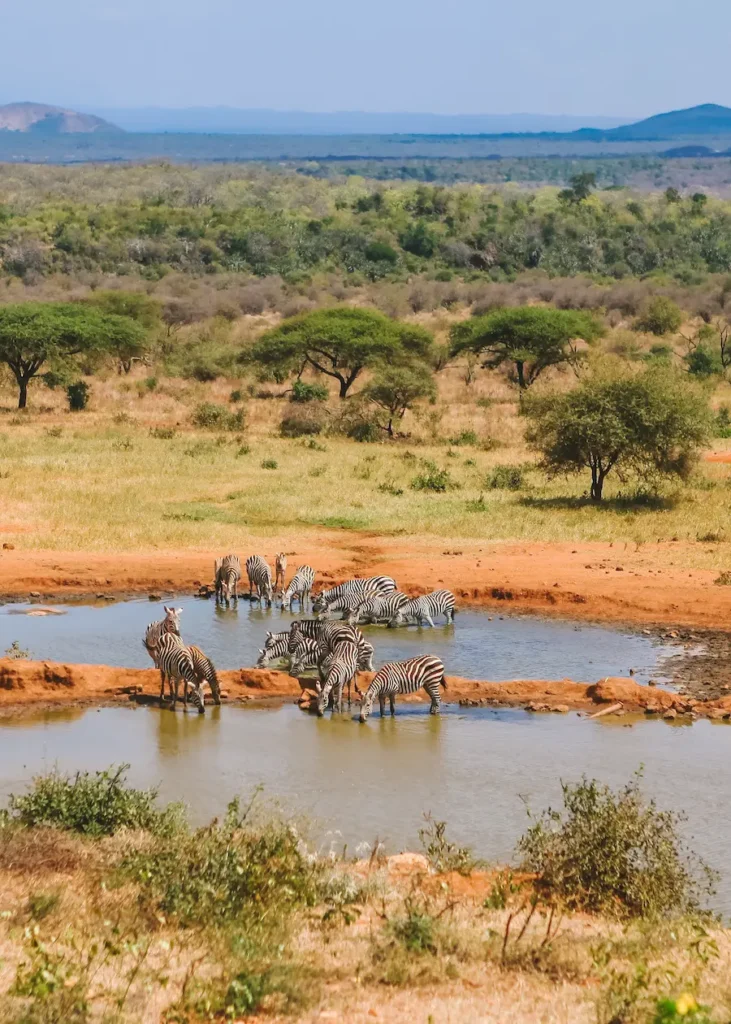
After the last 2 fantastic days at Amboseli with breathtaking views and so much wildlife, we then headed to the neighboring park, Tsavo West (2 hours drive), which is also home to all the Big Five. Tsavo (West + East), is HUGE!!
As we entered the park, we first encountered many green hills, then a huge lava flow, before entering a dense forest.
We also went on a short walking safari along the Mzima Springs, popular with hippos and crocodiles. Then, we spent the night in a superb lodge located inside the park!
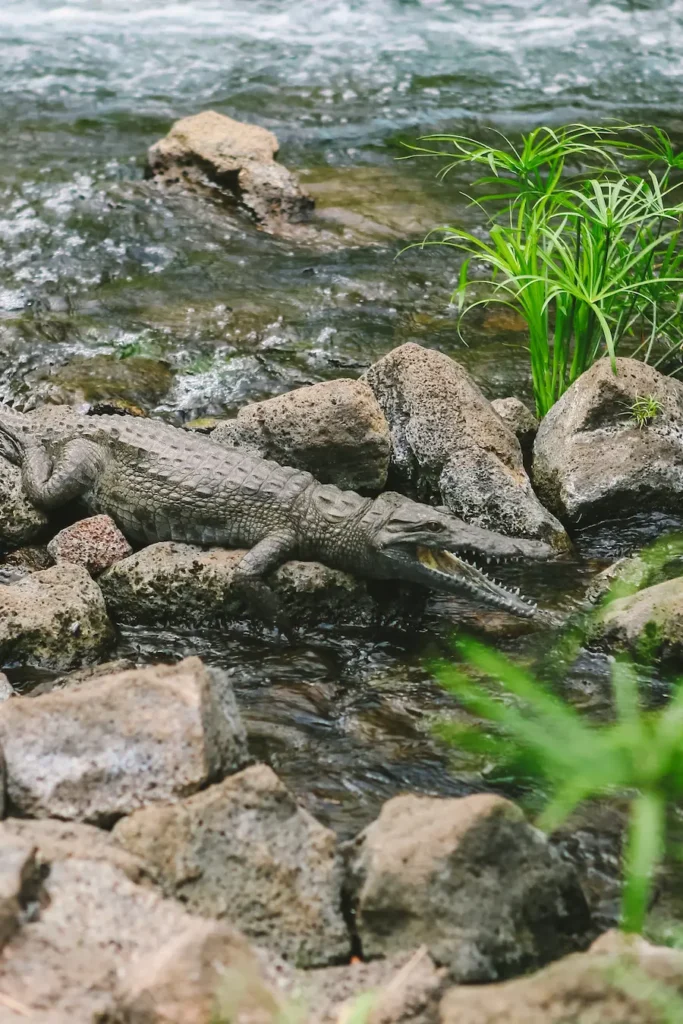
From our hotel, we had the best opportunities to observe wildlife, as there was a small waterhole nearby and the lodge itself sat on a hill overlooking the park. In contrast, the dense forests of Tsavo West made spotting animals during our game drives quite difficult, which was a bit disappointing. Besides, the park is really big!
Honestly, if it hadn’t been for our superb stay at Kilaguni Serena Safari Lodge, we would probably suggest skipping Tsavo West altogether and heading straight to Tsavo East, which we enjoyed much more overall.
We stayed one night at Kilaguni Serena Safari Lodge, and it turned out that the hotel itself was the main highlight of our visit to Tsavo West. We loved everything about it—the dining area, the bar overlooking the national park, our room with its beautiful view, and the excellent service throughout.
Tsavo East National Park
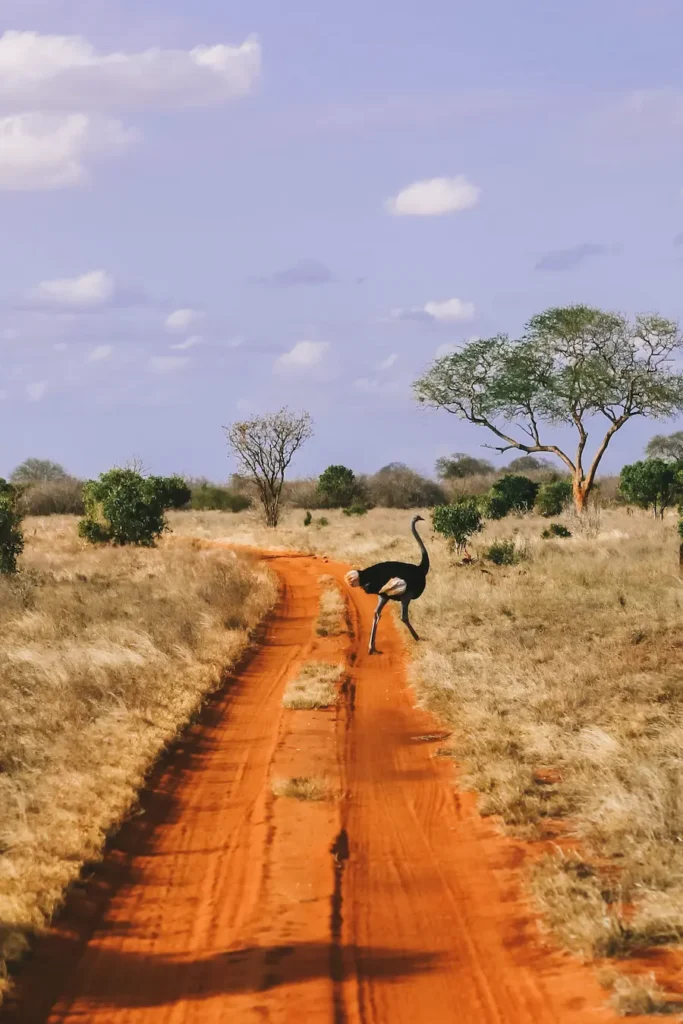
After another 3 hours’ drive, we reached our hotel at Tsavo East National Park. After Amboseli and Masai Mara, Tsavo East was our third favorite park!
The park is known for lions (including many males which don’t have manes) and elephants (which turn red after rolling in the red Tsavo dust). We also many Somali ostrich and lots of different antelope.
Birders also love this park, with more than 500 species recorded here.

Overall, we loved our game drives at Tsavo East. Especially the sharp red/orange soil, which made the park so special and perfect for photography.
We spent one night at Sentrim Tsavo Camp, which turned out to be our least favorite stay during the trip. It’s a tented camp, but a bit dated and far less impressive compared to the other lodges we experienced, especially after coming from the incredible Kilaguni Serena Safari Lodge.
If you plan to visit Tsavo East (which we highly recommend), it’s worth asking your agency for alternative accommodation options. The camp isn’t bad, but there are likely better choices available inside the park.
Diani Beach
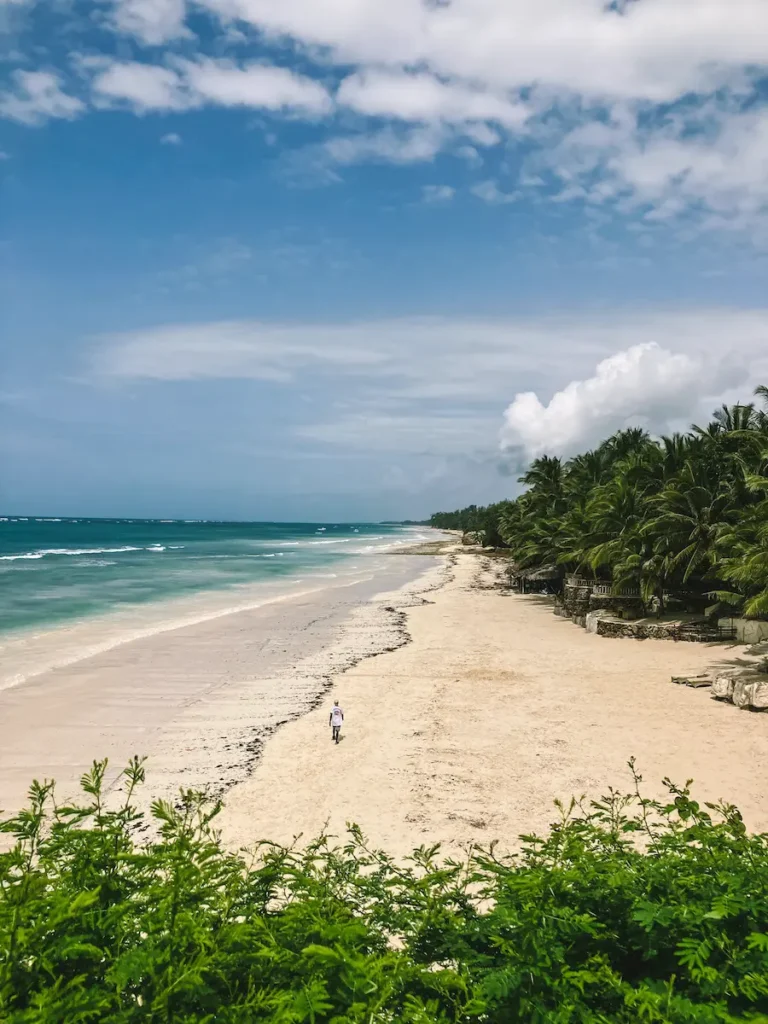
After 10 incredible days of wildlife safaris across Kenya’s national parks, we were excited to experience something different: the ‘marine wildlife.’ Our guide drove us another four hours to the final stop of this epic journey: Diani Beach!
Here, the endless stretch of white sandy beaches along the Indian Ocean immediately stole our hearts. For three nights, we were pampered at the Swahili Beach Resort, a truly spectacular hotel right on the beach, with crystal-clear turquoise waters at our doorstep.
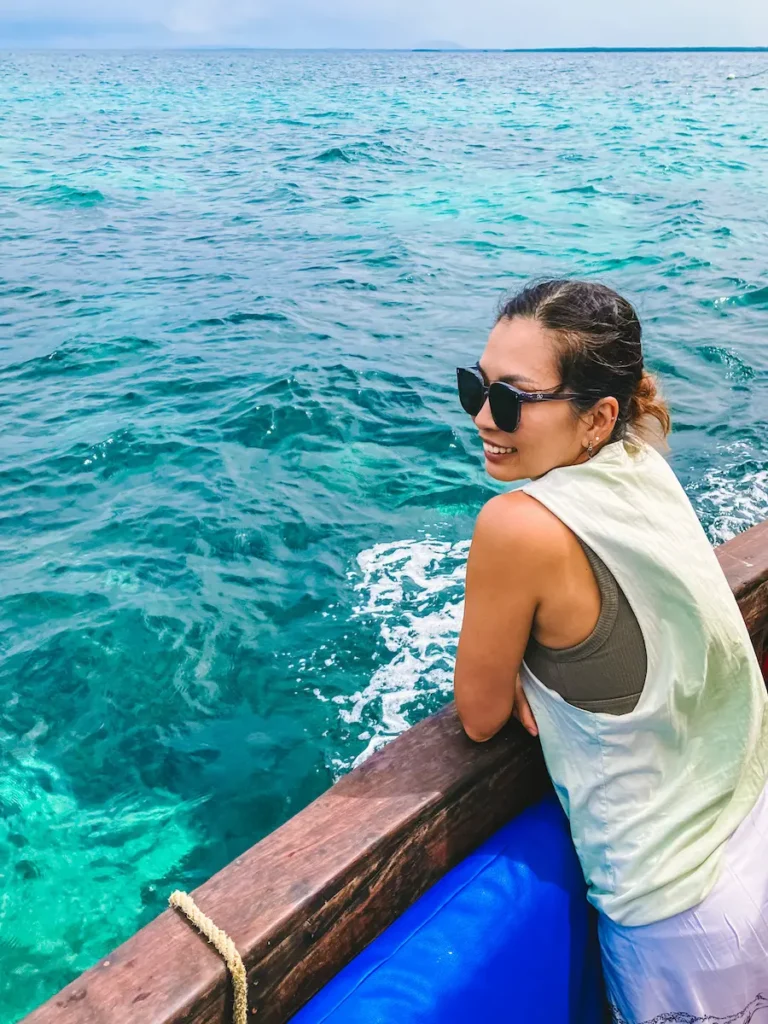
Our stay was a perfect blend of relaxation and adventure, lounging by the beach and pool, and exploring the underwater world on a fantastic day trip that included snorkeling, dolphin spotting, and a fresh seafood lunch on Wasini Island. Truly unforgettable!
For some reason, when people talk about Kenya, the amazing coastline doesn’t come first. But we were so glad that we added this extra stop to our itinerary. It allowed us to experience another side of Kenya, a bit lesser known but equally beautiful.
We stayed 3 nights at Swahili Beach Resort, and can absolutely 100% recommend this place. It was simply gorgeous with so many food options!
From Diani beach, we took a flight from Diani Airport directly to Nairobi. From Nairobi, we took a taxi as we landed in a different airport, and a few hours late,r we had our flight back home to Kuala Lumpur.
FAQs about a trip to Kenya
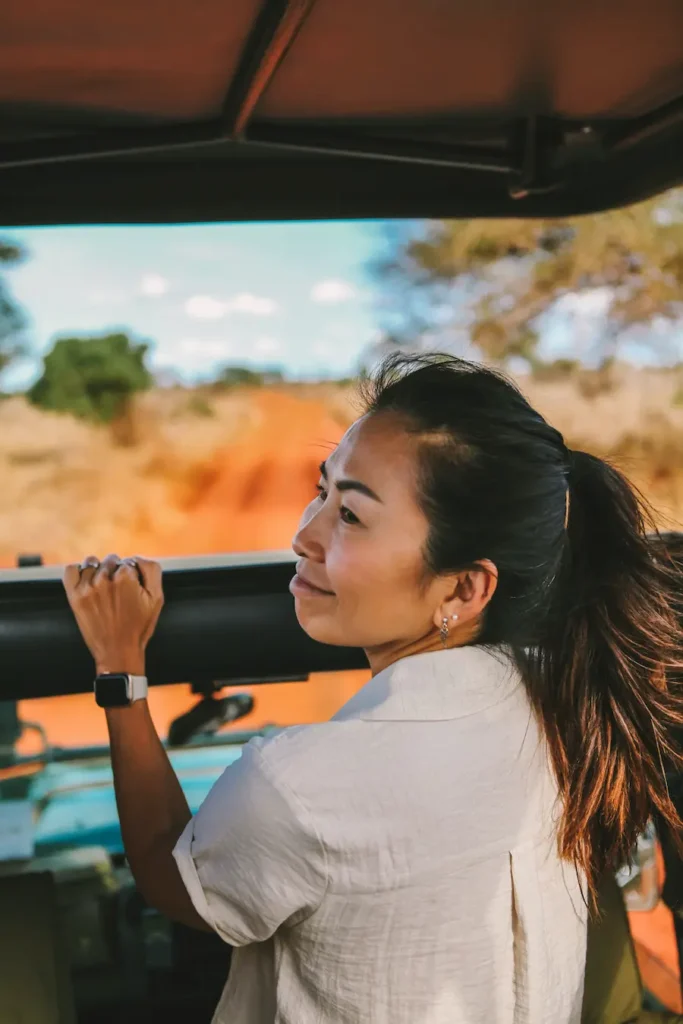
The best time to visit Kenya is during the dry seasons: January to March and June to October. These months are ideal for wildlife safaris, as animals gather around waterholes and are easier to spot. If you want to witness the Great Wildebeest Migration in the Masai Mara, plan your trip between July and August.
Yes, most travelers need a Kenya Electronic Travel Authorization (eTA), which replaces the previous visa system. You can apply online before arrival. Some nationalities may be exempt, so it’s best to check the official Kenya immigration website before your trip.
Yes, Kenya is generally safe for tourists, especially in popular safari destinations like the Masai Mara, Amboseli, Tsavo, and Diani Beach. However, as with any international travel, it’s important to stay alert in major cities like Nairobi and Mombasa, avoid isolated areas at night, and follow local safety advice.
Travelers are usually recommended to have Yellow Fever vaccination (mandatory if coming from a risk country), Malaria prevention medication, and up-to-date routine vaccines (Hepatitis A, Typhoid, Tetanus). Always consult your doctor or a travel clinic before your trip.
The currency in Kenya is the Kenyan Shilling (KES). Credit cards are accepted in most lodges, hotels, and major cities, but it’s wise to carry some cash for tips, small shops, and rural areas. ATMs are widely available in cities and airports. However, note that USD is also accepted in the touristy areas.
Pack lightweight neutral-colored clothing, a hat, sunscreen, insect repellent, binoculars, and a good camera. Evenings and mornings can be chilly, so bring a light jacket or sweater. Avoid bright colors as they attract insects and disturb the wildlife.
A safari in Kenya typically lasts 5 to 10 days, depending on how many parks you want to visit. A shorter safari can focus on one or two destinations like the Masai Mara and Amboseli, while a longer one allows you to explore Tsavo, Lake Nakuru and the coast at Diani Beach.
Tsavo East is known for its wide-open landscapes, red elephants, and excellent wildlife spotting opportunities.
Tsavo West has more dramatic scenery, volcanic hills, and dense vegetation, making it harder to spot animals but great for stunning landscapes.
If you’re short on time, many travelers prefer Tsavo East for wildlife viewing.
Absolutely! Like we did, you can combine safari adventures with a relaxing beach stay on the Kenyan Coast. The most popular beach destination is Diani Beach, where you can enjoy white sand beaches, snorkeling, diving, and fresh seafood.
The cost of a safari in Kenya varies depending on the parks you visit, the level of accommodation, and the length of your trip. On average, safaris range from $200 to $600 per person per day, including park fees, accommodation, meals, and game drives. Luxury lodges and private safaris will cost more, obviously.
Kenya has two official languages: English and Swahili. English is widely spoken in cities, hotels, and by safari guides, so communication is rarely an issue for travelers. Learning a few Swahili words like Jambo (hello) or Asante (thank you) will make your experience more fun and engaging.
Yes, travel insurance is strongly recommended for Kenya. It should cover medical emergencies, evacuation, trip cancellations, and theft. Safaris take place in remote areas, so having reliable coverage gives peace of mind.
Of course, feel free to reach out to us if you have any questions. You can leave us a message here, or on our social media. We reply within 24 hours.
In Conclusion about a trip to Kenya
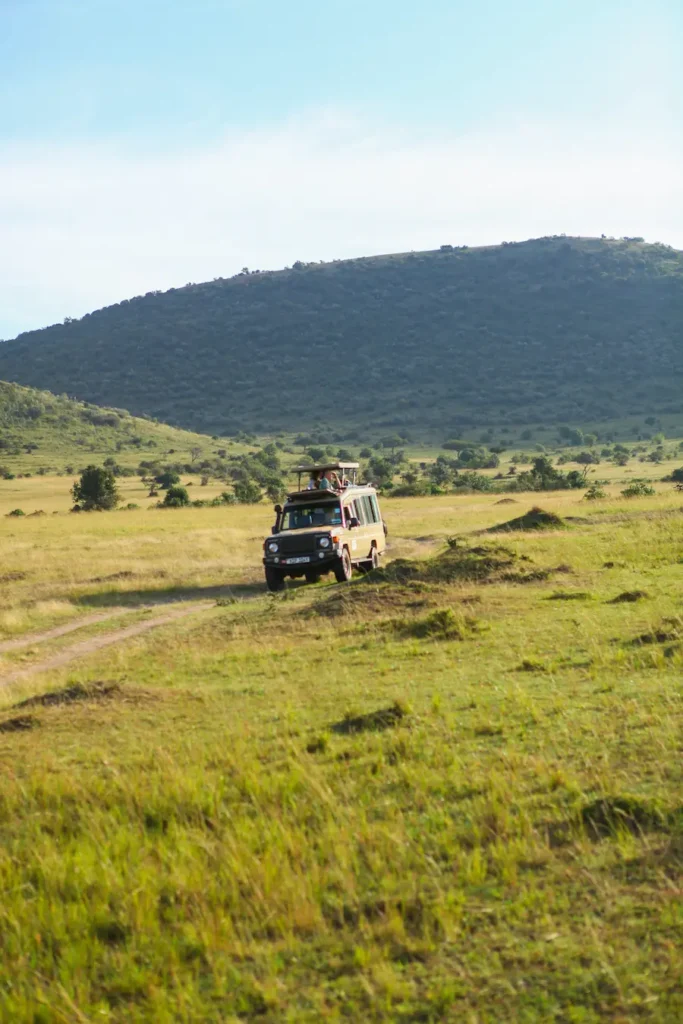
Our trip to Kenya was nothing short of unforgettable, a true once-in-a-lifetime adventure.
From breathtaking safaris and close encounters with wildlife to relaxing days on the pristine beaches of the Indian Ocean, every moment felt extraordinary.
Kenya captured our hearts with its raw beauty, warm hospitality, and incredible diversity. We left with memories we will cherish forever, and a deep desire to return one day to explore even more of this magical country.

